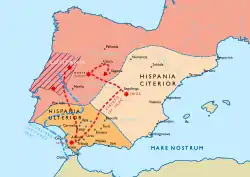Lusitanian War
The Lusitanian War, called Pyrinos Polemos ("the Fiery War") in Greek,[1] was a war of resistance fought by the Lusitanian tribes of Hispania Ulterior against the advancing legions of the Roman Republic from 155 to 139 BC. The Lusitanians revolted on two separate occasions (155 BC, and again in 146 BC) and were pacified. In 154 BC, a long war in Hispania Citerior, known as the Numantine War, was begun by the Celtiberians. It lasted until 133 and is an important event in the integration of what would become Portugal into the Roman and Latin-speaking world.
| Lusitanian War | |||||||||
|---|---|---|---|---|---|---|---|---|---|
 | |||||||||
| |||||||||
| Belligerents | |||||||||
| Roman Republic | Lusitanian tribes | ||||||||
| Commanders and leaders | |||||||||
|
Servius Sulpicius Galba Gaius Vetilius Gaius Plancius Gaius Nigidius Fabius Aemilianus Fabius Servilianus Quintus Servilius Caepio Marcus Popillius Laenas |
Viriathus Tautalus Curius Apuleius Punicus Caesarus Caucenus | ||||||||
Historical context
In the sequence of the Second Punic War, the Roman Republic defeats Carthage who had colonies in the Mediterranean Coast of the Iberian Peninsula. This marked the first incursion of the Roman Republic into the peninsula and possibly the first clash between Lusitanians and Romans, as the Lusitanians fought, during the Punic Wars, on the Carthaginian side as mercenaries.[2]
In 194 BC, a war broke out between the Romans and the Lusitanians, who were an autonomous people.[3] By 179 BC, the Romans had mostly succeeded in pacifying the region and signed a peace treaty.
From Punicus to the Peace Treaty of Atilius (155 BC – 152 BC)
The Lusitanian War starts in 155, when Punicus attacks some of its neighboring lands that belong to Roman subjects. In this raid, the Lusitanians kill 6000 Romans, including a quaestor named Terentius Varro. After this first victory, the Lusitanians gain the alliance of the Vettones and together lay siege to the Blastophoenicians, a Phoenician settlement subject to Rome. During this siege, Punicus is killed and is then succeeded by Caesarus.[4]
Mummius is sent from Rome to fight Caesarus. Caesarus is initially defeated but, while fleeing, managed to turn the battle around, killing 9000 Romans. Mummius takes his remaining soldiers (5000) and drills them in camp. He manages to later attack the Lusitanians by surprise, slaying a large number of them.[4]
The Lusitanians on the other side of the Tagus were led by Caucenus and invade the Cunei, who were subject to Rome, and capture Conistorgis. Some of the Lusitanians proceed to raid North Africa, laying siege to a city named Ocile. Mummius follows them into Africa, achieving victory against the Lusitanian rebels and ending the siege of Ocile. With this victory, Mummius returns to Rome and is awarded a triumph.[4]
Mummius is succeeded by Marcus Atilius, who fights the Lusitanians killing 700 of them and taking their largest city, Oxthracae. This terrifies the neighboring tribes (including the Vettones), which make terms of surrender.[4]
Second Lusitanian Raid and the Treachery of Galba (152 BC – 150 BC)
During the winter of 152 BC, the Lusitanians rebel again, besieging some Roman subjects. Servius Galba, the successor of Atilius, rushes to rescue them. After an initial victory, Galba is defeated while trying to pursue the fleeing Lusitanian forces. About 7000 Romans are killed and Galba takes refuge in a settlement called Carmone. He then reassembles his forces and winters in Conistorgis. Lucullus was wintering in Turditania. When he discovers that Lusitanians were nearby, he starts by attacking those nearby Lusitanians (killing 4000), then those crossing the straits near Gades (killing another 1500 of them) and then sets off to invade Lusitania. Galba joins in the invasion of Lusitania.[4]
In 150, as a result of Lucullus and Galba's invasion, the Lusitanians send ambassadors to Galba to renew the treaty they made with Atilius in 152 BC. Galba pretends to accepts a truce and promises them fertile land. The Lusitanians, following the good news of the ambassadors, come together at a place appointed by Galba and are divided into three parts in a plain. Galba approaches each division separately, asks the Lusitanians there to lay down their arms and slaughters them. A few Lusitanians escape, namely, Viriathus.[4]
Third Lusitanian Raid and the Feats of Viriathus (148 BC – 140 BC)
.jpg.webp)
In 148 BC, the Lusitanians assemble a force of 10000 and attack Turdetania. Gaius Vetilius is sent to deal with the raid, amassing a force equal to those of the Lusitanians in numbers. Vetilius wins against the Lusitanians, who ask for peace terms. As peace terms were being arranged, Viriathus reminds his fellow Lusitanians of the treachery of the Romans, which he had witnessed first hand with Galba. The Lusitanians choose Viriathus as their leader and obey his escape plan: they should organize as if going into battle, but then flee in every direction and later reassemble in a city named Tribola. Vitilius, seeing the Lusitanian forces scattering, decides to attack Viriathus head on, but Viriathus (and 1000 of his best men) proceeds to flee and attack repeatedly, occupying Vitilus for enough time (two days) for the others to flee to safety and then flees himself to join them. With this feat, Viriathus gains great fame and reinforcements from neighboring tribes.[4]
Viriathus was to gain renown throughout the Roman world as a guerrilla fighter. In the words of Theodor Mommsen, "It seemed as if, in that thoroughly prosaic age, one of the Homeric heroes had reappeared." In 148 BC, Vitilius follows Viriathus into Tribola. Viriathus' forces ambush the Romans. About 6000 Romans manage to flee to Carpessus with their quaestor, the remaining of the original 10000 being either killed or imprisoned. Vitilius himself is killed during this ambush, as he was considered to be of little worth as a slave (he supposedly was old and fat). The Quaestor asks for reinforcements from the Roman allies Belli and Titii, who send about 5000 men, but all are slayed in skirmishes against Viriathus' forces.[4]
In 146 BC, Viriathus raids Carpetania until Gaius Plautius Hypsaeus comes from home bringing 10000 men on foot and 1300 on horse. Plautius is defeated by Viriathus, who then proceeds to raid the country without check.[4]
In 145 BC, the general Quintus Fabius Maximus Aemilianus is sent by Rome to fight the Lusitanians. With the end of the wars against Carthago and Greece, Maximus managed to assemble a great force: 15000 men on foot and 2000 on horse. The forces assemble in Orso and skirmish with the Lusitanians frequently, but without full-scale battle.[4]
In 144 BC, Maximus attacks Viriathus and manages to put him into flight and capture two of his cities. Maximus pursues Viriathus into a place called Baecor, killing many of his men and failing to capture Viriathus. Maximus winters in Córdoba and then leaves to Rome, to be succeeded by Quintus Pompeius Aulus.[4]
In 143 BC, Viriathus managed to persuade several Celtic tribes (Arevaci, Titii, and Belli) to resist the Romans, leading to the Numantine War. Afterwards, Viriathus skirmishes with Quintus, takes refuge in a place called Venus mountain, but later returns to battle, slaying 1000 of Quintus' men, drove out the garrison of Ittuca and raided Bastetani. Quintus winters at Córdoba in the middle of Autumn and sends Caius Marcius, a Hispanic from Italica, to fight Viriathus.[4]
In 142 BC, Fabius Maximus Servilianus succeeds Quintus, bringing two new legions and more allies, up to a total of 18000 men on foot and 1600 on horse. Maximus asks for reinforcements from Africa and is attacked by Viriathus, who does not succeed in disrupting Maximus' plans. Maximus is reinforced by 300 horse and ten elephants. Maximus wins over Viriathus, who flees but manages to inflict 3000 deaths and to drive the Romans back to camp. The Romans are saved by night time and manage to defend their camp initially, but after constant attacks from Viriathus during the night or during the heat of day, fall back to Itucca. Viriathus returns to Lusitania and Maximus, instead of following him, raids five towns in Baeturia, who had sided with the Lusitanians. Afterwards, he marched against the Cunei and only then into Lusitania.[4]
While moving against Viriathus, Maximus is attacked by Curius and Apuleius, who led 10000 men. Curius is killed in battle and Maximus succeeds in capturing the Lusitanian cities of Escadia, Gemella, and Obolcola. Maximus captures around 10000 men, beheaded 500 and sold the rest as slaves. While following Viriathus, Maximus' army rested in Erisana. Viriathus manages to infiltrate the town and, in defeating Maximus' armies, asks for the end of the war.[4]
Caepius, death of Viriathus and the end of the Lusitanian War

In 140 BC, Fabius Maximus Caepius succeeds Maximus and writes to Rome complaining of the treaty made with Viriathus, saying it was unworthy of the dignity of the Roman people. The Senate first only allows Caepius to fight Viriathus secretly, but then decides to break off the treaty and declare war against Viriathus. Caepius took the town of Arsa and wins a battle over Viriathus (who flees) in Carpetania. As Viriathus flees, Caepius turns against the Vettones and Callaici, destroying their fields.
Afterwards, Viriathus sends his most trusted friends Audax, Ditalcus and Minurus to negotiate peace terms with Caepio. Caepio bribes them, ordering them to assassinate Viriathus. Viriathus slept little and in his armor, but allowed his friends to enter his tent at any time, so he could be summoned to battle as soon as possible. Taking advantage of this, his friends entered his tent and killed him in his sleep, slitting his throat. Viriathus is only found dead in the morning, when the traitors were long gone. Unable to avenge him as they knew not who murdered him, they instead held a grand funeral: they dressed Viriathus in special garments, burned him in a pyre, held processions, gladiator battles and songs.[4] After the funeral, the popular story of the traitors' fate has Roman general Servilius Caepio having them executed, declaring "Rome does not pay traitors".
After the death of Viriathus, Tautalus is elected to lead the Lusitanians. The Lusitanians attempt to raid Saguntum, but fail. On crossing the river Baetis on their return, they are defeated by Caepio and accept to become Rome's subjects. This marks the end of the Lusitanian War.[4]
Aftermath
The end of the Lusitanian Wars marks a period of relative peace in Lusitania. The Lusitanians will rise against the Romans only many years later, in 80 to 72 BC, in the Sertorian War, when they recruit the outlaw ex-general Quintus Sertorius to lead a rebellion against Rome. The Lusitanian War, and Viriathus in particular, would become an enduring symbol of Portuguese nationality and independence (see Lusitanic).
See also
Notes
- This is the name used in Polybius and Appian.
- Egan, Julia. "Comparative Resistance in Iberia: the Turdetanians and the Lusitanians". Studies in Mediterranean Antiquity and Classics. 3.
- Appian's History of Rome
- Appian's Roman History, Book VI. https://archive.org/details/appiansromanhist01appi/page/226/mode/2up
Sources
- Appian's History of Rome.
- Wintle, Justin. The Rough Guide History of Spain. Rough Guides, 2003.
- Encyclopaedia Romana; "The Celtiberian War and Numantia".
